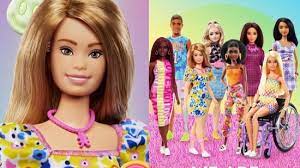Monitoring Desk
NEW YORK: Mattel Tuesday welcomed its first-ever Barbie doll representing a person with Down’s syndrome aimed at pushing for its diversity mission and countering stigma around physical disabilities.
The American multinational toy manufacturing company has crafted the doll as part of its Barbie Fashionistas line which introduces children to a range of diverse representations of beauty, CNN reported.
Previously, the company launched a Barbie with a prosthetic leg, one using a wheelchair, another with hearing aids, and one with vitiligo — a condition in which patches on one’s skin lose pigment.
To produce the latest doll in its collection and ensure appropriate representation of a person with Down’s syndrome, the company worked with the National Down Syndrome Society (NDSS) to form its features, shape, clothing, packaging and accessory.
Down’s syndrome is a genetic condition which affects the individual’s cognitive ability, resulting in mild to severe learning disabilities as well as distinctive characteristics of the face.
“Our goal is to enable all children to see themselves in Barbie, while also encouraging children to play with dolls who do not look like themselves,” said Lisa McKnight, Mattel’s executive vice president and global head of barbie & dolls.
She added that the company’s goal is to “counter social stigma through play” through its dolls.
“Doll play outside of a child’s own lived experience can teach understanding and build a greater sense of empathy…. We are proud to introduce a Barbie doll with Down syndrome to better reflect the world around us and further our commitment to celebrating inclusion through play,” McKnight said.
Meanwhile, NDSS president and CEO Kandi Pickard said that Mattel’s latest Barbie is a “huge step forward for inclusion and a moment that we are celebrating.”
“This means so much for our community, who for the first time, can play with a Barbie doll that looks like them. This Barbie serves as a reminder that we should never underestimate the power of representation,” said in a statement.
To diversify its 64-year-old iconic Barbie brand, Mattel has recently adopted a much more inclusive approach. Since debuting Barbie dolls in 1959, the company continued to face criticism for propagating unrealistic expectations for a female body type by manufacturing tall, slender, blonde and light-skinned dolls over the years with a narrow waists, an ample bosoms and walking with high heels.
After facing a steep in sales, the company forayed into crafting dolls with realistic body types in 2016 reintroducing them in four different body types, seven skin complexions, 24 hairstyles and 22 eye colours.
The Barbie Fashionistas line was introduced three years later.







